|
Art in the Armed Forces; Pictured by Men in Action,
edited by Aimée Crane was published in 1944. It featured drawings, paintings and other
art by members of the U.S. armed forces in World War II. I've used a few aviation images
to illustrate pages of this site. The image name, medium and artist's name are listed
below, along with the page number from the book, and any caption provided. Below, is a
short bio of the artist, as of 1944.
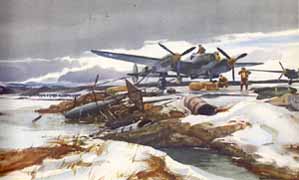 |
P-38, Dispersal Area
Watercolor, page 33
by Capt. Ogden M. Pleissner, USAAFThe P-38 pilot prepares for his flight over many
miles of forbidding slate grey ocean. Through ocean, snow and dense clouds which conceal
the solid walls of mountains, he finally makes his run over the enemy positions where the
air becomes hot with flack and machine gun fire.
|
| Although in civilian life Captain Pleissner makes his
home in New York, he spends a great deal of his time traveling and painting in may parts
of this country. From Wyoming to Vermont, in parts of the South and while on fishing trips
to Quebec and New Brunswick, he painted as he went, the various impressions that each
place gave him. Pleissner has had many one-man shows and his watercolors and oil paintings
are shown in all the important National exhibitions. His work is represented in leading
museums throughout the country. In 1941, on assignment from the Office of Emergency
Management, he visited various Defense plants and painted a series of watercolors
depicting the work and activities of our war workers. In January, 1943 he joined the Air
Corps and after training was ordered to Alaska and the Aleutians. It was in these places
where, attached to the 11th Air Force, he recorded the life and activities of our airmen. 
|
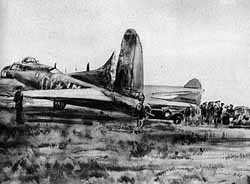 |
Secretary Stimson Examines the Shattered Tail of a B-17
page 41
by T/Sgt. Albert Gold, USA |
| A native of Philadelphia, Gold has been painting ever
since he can remember. Started to exhibit his work at the age of 19. Studied at the School
of Industrial Art and under Franklin Watkins. He has exhibited in group shows since 1935,
held a one-man show at the University of Pennsylvania in 1939, was included in the 1942-43
"Artists for Victory" show at the Metropolitan Museum in New York City, and won
the Prix de Rome ($1000.00) in 1942. His painting can be found in the collections of many
large museums. Very fond of music, he plays the violin and collects records. He is one of
the twelve men chosen by the Army to execute drawings on the different battlefields. At
present is serving with the armed forces in Great Britain. 
|
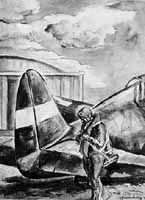 |
After the Mission
page 41
by T/Sgt. Manuel Bromberg, USAThe pilot has an amazing way of being casual about
what he has done and seen - just another day's work. |
| Born in Centerville, Iowa in 1917. Studied at the
Cleveland School of Art and also under Boardman Robinson at the Colorado Springs Art
Center where he later became a life drawing instructor. He has won many prizes, on
of which was the 48-States Mural Competition for the Post Office at Graybill, Wyoming. He
has exhibited in many major national shows in leading cities and is represented in museums
in the United States and Canada. Besides painting, he is interested in stage designing and
plays the violin. He was inducted into the Army in 1942 and is now in Great Britain
graphically recording GI war experiences. 
|
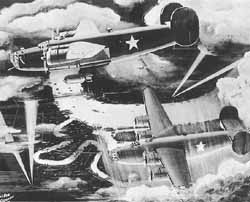 |
Bombing Mission
Gouache, page 53
by Sgt. Kenneth Gordon, USA |
| He is a commercial artist from Cleveland, Ohio.
Entering the Army, he was stationed at Keesler Field, Mississippi where he executed a
mural for a day-room and completed many studies of B-24 bombers, which are used in the
instruction of mechanics for servicing this type of plane. 
|
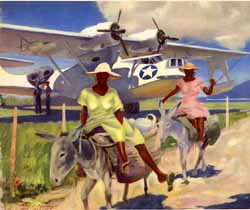 |
Transportation, Old and New
Watercolor, page 124
by Lt. Albert K. Murray, USNR |
| Born in Emporia, Kansas in 1906. Attended the College
of Fine Arts at Syracuse University; studied art in New York City, in Mexico and at the
National Gallery in London, England. He is represented in the permanent collection at
Syracuse University. In May of 1942 he joined the Navy and reported to Port Everglades,
Florida to the Naval Section Base, where he remained until transferred to the Office of
Public Relations, Washington, D.C. He was then assigned to the Art and Poster Section as a
combat artist to paint various Naval activities for Public Relations use and for the
historical record. A well-known portrait painter before the war, one of his earliest
assignments was to paint portraits of the Navy's General Board. After this he completed a
series of charcoals and oils of the men of the U.S. S. BOISE. Now in the Caribbean, he is
busy painting the PBMs on patrol, PC boats on convoy duty, the building of bases,
construction of drydocks and other activities connected with the war. 
|
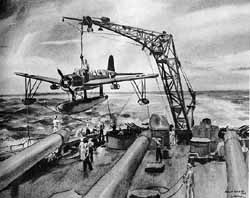 |
Kingfisher Nesting
Watercolor, page 145
by Lt. Dwight Shepler, USNRAn OS2U Scout Plane is hoisted aboard by the big crane
on the fantail as the gunner supervises the hood. |
| Born at Everett, Massachusetts in 1905. Graduated from
Williams College. He is a member of the American Artists Group and the American Artists
Professional League, and has had his work exhibited at the Chicago Art Institute, the
Pennsylvania Academy of Fine Arts and the Boston Museum of Fine arts. For several years he
has had an annual one-man show in Boston, New York and Chicago. Before joining the Navy,
he taught watercolor painting at several Boston Art Schools; wrote articles and did
portraits as illustrations for the Boston Herald of "personalities in the news;"
created advertising illustrations for Sun Valley, the Sun Oil Company and others. His sea
experience has been varied and extensive. In 1936-37 he sailed as mate and assistant
navigator on a schooner from Wood's Hole, Massachusetts to Ecuador, Galapagos,
Clippertown, San Pedro, Balboa and Guantanamo. He also did a great deal of deep water
cruising around New England and abroad. After attending Indoctrination School at
Northwestern University, his first assignment was aboard a destroyer on convoy in the
Pacific. Later he saw duty on a cruiser, a battleship and on Guadalcanal. During the time
Schepler was attached to a cruiser, he had a battle station topsides and was on deck
during several important actions, notably the Battle of Santa Cruz. His ship was in the
thick of the fighting and a Jap bomb went through the fantail, exploding below. Shepler,
fortunately, was uninjured. His pictures of this action make one feel the perils involved
and his portrayals of the battle are moving and vivid pictures of our gallant men and
ships. In the mud and dust of Guadalcanal, Shepler spent three weeks recording as an eye
witness the momentous days of struggle that the men endured during that campaign. Since
his Pacific duty, Shepler has been ordered to the European theatre of war. En route on a
convoy he painted several fine pictures showing the ship o a fog-ladened sea steering a
hazardous course to safety after having become lost from its escort. Shepler was promoted
to the rank of Lieutenant in April of 1943. 
|
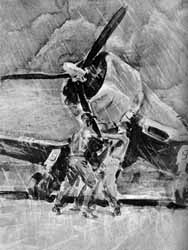 |
Night - Henderson Field
Watercolor, page 184
by T/Sgt. Herbert H. Laidman, USMC |
| While serving with a Marine aviation unit on
Guadalcanal, this thirty-year-old New Yorker, contracted chronic malaria and spent long
periods in the hospital. In spite of this, he managed to send back more than sixty
watercolors and dozens of pencil and wash drawings. Many of them were exhibited at the
National Gallery of Art in Washington, D.C. and at the Museum of Modern Art in New York
City. At present he is in charge of the art department in the Marine Corps Public
Relations Bureau, at Washington, D.C. |
|